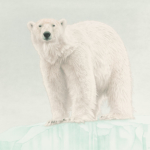Endangered Species: theme 04: endangered species
/in Exhibitions Gallery /by Adrienne DawsonSeptember 8, 2018 - January 6, 2019
Lightcatcher Building
fourth theme
endangered species:
plants and animals on the edge of survival
One step away from extinction, the plants and animals interpreted by artists here have come to symbolize the threatened ecosystems in which they live and the global dimension of declining biodiversity. The artworks call attention to just a few of the ten thousand endangered and critically endangered species classified by the International Union for the Conservation of Nature.
Nineteenth-century artists John James Audubon and George Catlin were among the earliest Americans to lament the loss of animals and their habitats. They catalogued biodiversity and documented species in danger of extinction, including the American bison, as the nations of North America expanded their continental footprints. The loss of the bison, a keystone species for ensuring a healthy ecosystem, was calamitous to Native Americans and the grasslands of the Great Plains. Its near extermination by 1898 was a wake-up call that bolstered the conservation movement.
Since the 1980s, artists’ concerns about the loss of biodiversity have coalesced around a multiplicity of media and styles that mirror the diversity of species at risk. Drawing from scientific naturalism, conservation photography, Pop art, Surrealism, and Formline art, among others, artists create works that garner empathy and command attention. They provocatively confront the extinction crisis that was merely intuited in nineteenth-century art.
Works by today’s artists assume ever greater importance as the current federal government begins to dismantle more than a century of legislation protecting life and land.
As image makers and conceptual visionaries, artists have the capacity to heighten public awareness about the current condition of life and environmental distress.
-

- George Catlin, American, 1796–1872; Buffalo Bull, Grazing on the Prairie, 1832–1833; Oil on canvas, 24 x 29 in. Smithsonian American Art Museum, Gift of Mrs. Joseph Harrison Jr.
-

- Antoine Louis Barye, French, 1796-1875; Wolf Holding a Stag by the Throat, modeled 1843 (cast date unknown); Bronze, 15.25 x 5.5 x 8.5 in. Whatcom Museum, Gift of Julie Ward, 1991.2.1.
-

- Nicholas Galanin, Tlingit-Aleut, b. 1979; Inert Wolf, 2009; Wolf pelts and felt, 74 x 65 x 24 in. Courtesy of the Burke Museum of Natural History and Culture, catalogue number 2012-83/1.
-

- Madeline von Foerster, American, b. 1973; Carnival Insectivora (Cabinet for Cornell and Haeckel), 2013; Oil and egg tempera on panel, 20 x 16 in. Collection of John Brusger.
-

- Nick Brandt, British, b. 1964; Line of Rangers Holding the Tusks of Elephants Killed at the Hands of Man, Amboseli, from the book Across the Ravaged Land, 2011; Archival pigment print, 44 x 78 in. Courtesy of the artist.
-

- Michael J. Felber, American, b. England, 1946; Arctic Father, 2017; Colored pencil, 22.5 x 30 in. ©Michael Felber 2018. Courtesy of the artist.
-

- Preston Singletary, American Tlingit, b. 1963; Killer Whale, made at Museum of Glass, 2009; Blown glass and sand-carved glass 25 x 16 x 7 in. Collection of Museum of Glass, Tacoma, Washington. Gift of the artist.
-

- Julie Andreyev & Simon Lysander Overstall, Canadian, b. 1962 and 1969; Salmon People, 2014-2015; Video, 5:00 minutes, 51-inch plasma monitor. Courtesy of the artists.


